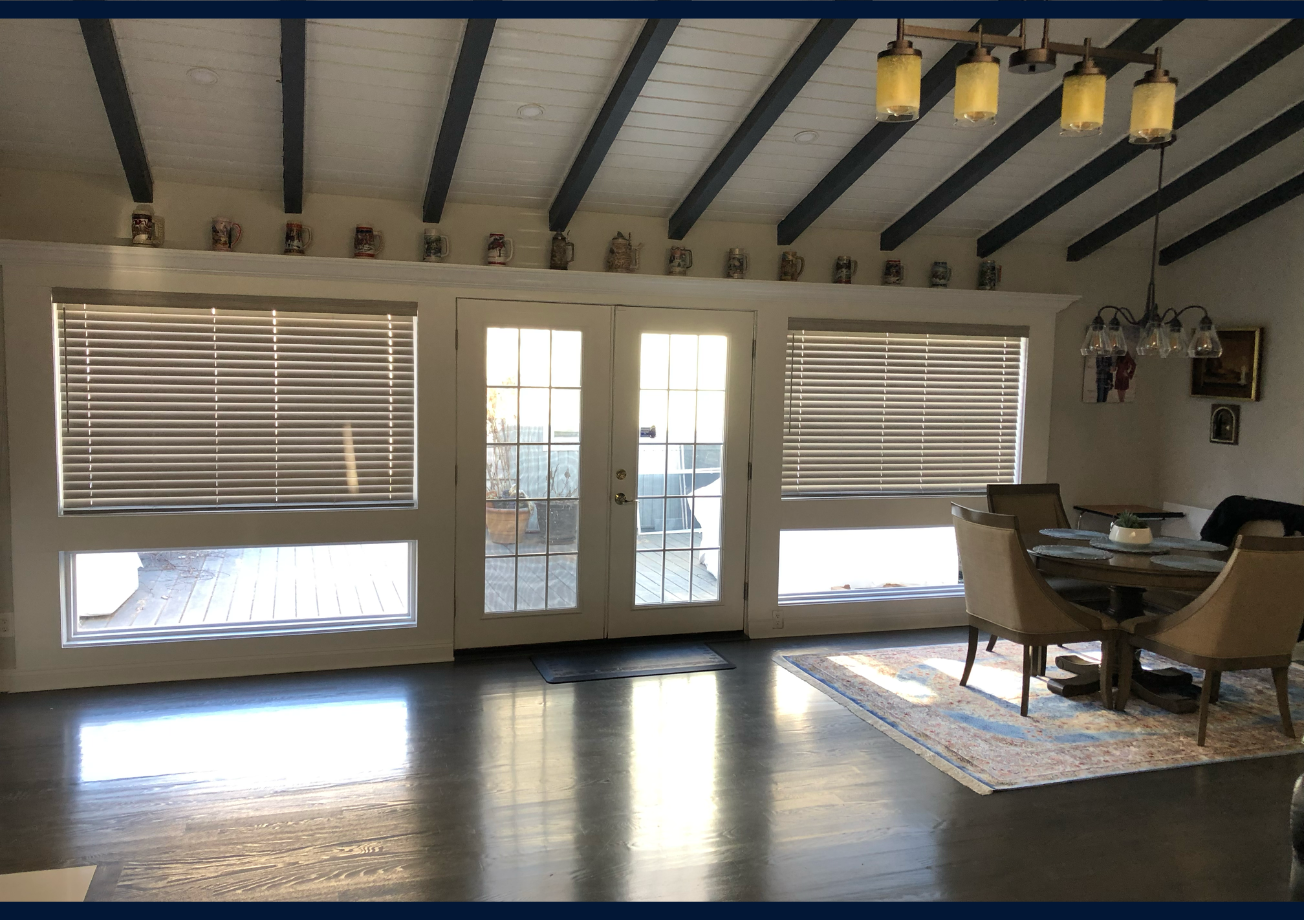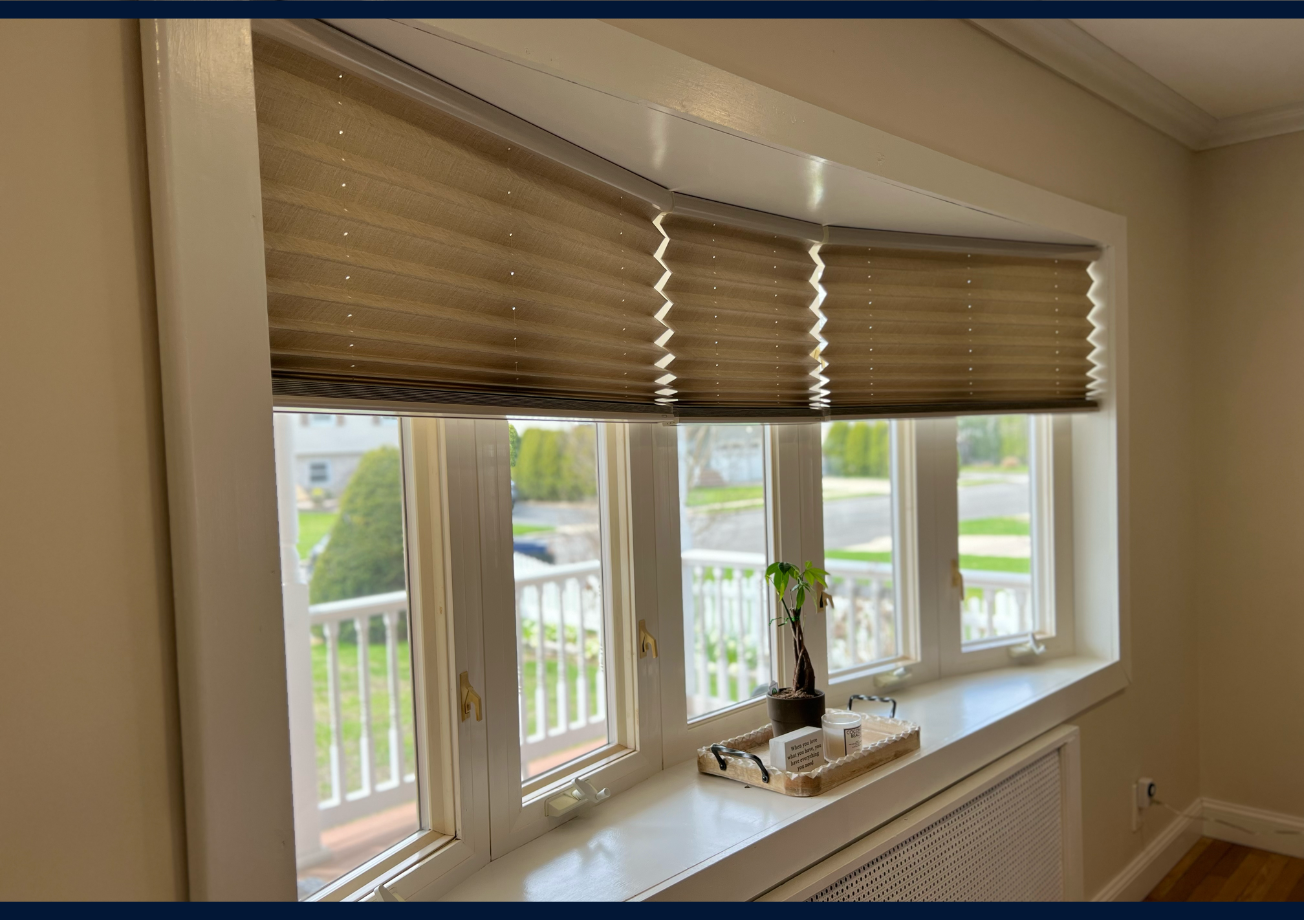When shopping for window treatments, you’ll encounter three main categories: blinds, shades, and shutters. While they all serve the fundamental purpose of controlling light and privacy, each offers distinct advantages and characteristics that make it suitable for different situations and preferences.
Understanding these differences is crucial for making an informed decision that aligns with your home’s style, functional needs, and budget. This comprehensive comparison will help you navigate the unique features, benefits, and ideal applications for each window treatment type, ensuring you select the perfect solution for your Long Island home.
Understanding Blinds: Adjustable Light Control at Your Fingertips
Blinds consist of individual slats or vanes that can be tilted to control the amount and direction of light entering your room. This adjustability makes them incredibly versatile for various lighting conditions throughout the day.
How Blinds Work: The slats rotate on a central mechanism, allowing you to fine-tune light levels from completely closed to fully open, with numerous positions in between. This precise control makes blinds ideal for rooms where lighting needs change frequently.
Types of Blinds:
Horizontal Blinds (Venetian Style):
- Available in 1-inch, 2-inch, and 2.5-inch slat widths
- Materials include wood, faux wood, aluminum, and vinyl
- Slats tilt to direct light upward or downward
- Compact when fully raised
Vertical Blinds:
- Individual vanes hang vertically from a head rail
- Vanes rotate to control light and can be drawn to one side
- Excellent for wide windows and sliding doors
- Available in fabric, vinyl, and aluminum materials
Mini Blinds:
- Narrow 1-inch slats provide a sleek appearance
- Aluminum construction offers durability and affordability
- Ideal for smaller windows and contemporary spaces
- Available in numerous colors and finishes
Advantages of Blinds:
- Precise light control with adjustable slats
- Wide range of materials and price points
- Easy to clean and maintain
- Classic style that works with most décor
- Excellent for rooms requiring frequent light adjustments
Potential Drawbacks:
- Individual slats can collect dust
- Cords and mechanisms may require occasional maintenance
- Less insulation compared to cellular shades
- Can appear busy in rooms with multiple windows
Exploring Shades: Soft Style with Functional Benefits
Shades are made from a continuous piece of material that raises and lowers as a single unit. Unlike blinds, they don’t have individual adjustable components, creating a cleaner, more unified appearance.
How Shades Work: Most shades operate on a simple lift mechanism, rolling or folding upward when raised. Some styles offer limited light control through fabric opacity, while others provide top-down/bottom-up functionality for privacy with natural light.
Popular Shade Styles:
Roller Shades:
- Single piece of fabric that rolls around a cylinder
- Available in light-filtering, room-darkening, and blackout options
- Clean, minimalist appearance
- Numerous fabric choices and custom printing options
Roman Shades:
- Fabric panels that fold into horizontal pleats when raised
- Available with various fold styles (flat, hobbled, balloon)
- Elegant, tailored appearance
- Extensive fabric and pattern options
Cellular/Honeycomb Shades:
- Engineered with air-trapping cells for insulation
- Available in single, double, or triple cell construction
- Superior energy efficiency
- Light-filtering and blackout options available
Solar Shades:
- Specially designed to block UV rays while maintaining views
- Measured by openness percentage (1% to 14%)
- Excellent glare reduction for electronics
- Protect furniture and flooring from sun damage
Advantages of Shades:
- Clean, uncluttered appearance
- Superior insulation properties (cellular styles)
- Extensive fabric and color options
- Excellent for creating ambiance and style
- Generally easier to operate than multi-component blinds
Potential Drawbacks:
- Limited light control compared to adjustable blinds
- Fabric options may require more careful cleaning
- Higher-end materials can be more expensive
- Less durability in high-traffic areas
Discovering Shutters: Permanent Elegance and Value
Shutters are permanent window coverings made of hinged panels with adjustable louvers. They’re essentially built-in window treatments that become part of your home’s architecture.
How Shutters Work: Individual louvers tilt to control light, while the panels can swing open for complete window access. This dual functionality provides maximum flexibility for light, privacy, and ventilation control.
Shutter Styles:
Plantation Shutters:
- Wide louvers (2.5 to 4.5 inches) for contemporary appeal
- Available in wood, composite, or vinyl materials
- Can be custom-configured for any window shape
- Bi-fold, tri-fold, or sliding track options for wide openings
Traditional Shutters:
- Narrower louvers (1.25 to 2.5 inches) for a classic appearance
- Often used in colonial or traditional home styles
- Available in painted or stained wood finishes
- Café-style covers only the bottom portion of the windows
Specialty Shutters:
- Shaped shutters for arched, circular, or unique windows
- Tier-on-tier systems for different privacy levels
- Sliding shutters for extremely wide openings
- Exterior shutters for additional curb appeal
Advantages of Shutters:
- Permanent installation adds home value
- Superior durability lasting decades
- Excellent insulation and noise reduction
- Complete privacy when closed
- Timeless style that never goes out of fashion
- Easy to clean with regular household products
Potential Drawbacks:
- Higher initial investment compared to other options
- Professional installation required
- Limited style flexibility once installed
- May not suit all architectural styles
- Louvers can collect dust like blinds
Comparing Performance Characteristics
Light Control:
- Blinds: Excellent adjustability with tilting slats
- Shades: Good control through fabric opacity choices
- Shutters: Superior control with adjustable louvers and swinging panels
Privacy:
- Blinds: Very good when slats are closed
- Shades: Excellent with room-darkening or blackout options
- Shutters: Excellent with complete closure capability
Energy Efficiency:
- Blinds: Moderate insulation, better with wood materials
- Shades: Excellent with cellular construction
- Shutters: Very good with solid panels and multiple air layers
Durability:
- Blinds: Good to very good, depending on materials
- Shades: Good with quality fabrics, varies by construction
- Shutters: Excellent, often lasting 20+ years
Maintenance:
- Blinds: Moderate, individual slats require dusting
- Shades: Easy to moderate, depending on fabric
- Shutters: Easy, simple wiping keeps them clean
Making the Right Choice for Your Home
Choose Blinds When:
- You need precise, adjustable light control
- Budget is a primary consideration
- You prefer classic, versatile styling
- Windows require frequent light adjustments
- You have standard-sized windows
Choose Shades When:
- You prioritize a clean, uncluttered appearance
- Energy efficiency is important
- You want extensive fabric and color options
- Room ambiance and décor coordination matter
- You prefer simple operation
Choose Shutters When:
- You’re making a long-term investment
- Home value increase is important
- You want permanent, architectural window treatments
- Superior durability is required
- Prefer traditional or classic home styling
Style and Home Architecture Considerations
Your home’s architectural style should influence your decision. Traditional colonial homes often benefit from shutters or wood blinds, while contemporary spaces might call for sleek roller shades or aluminum blinds. Consider window size, room proportions, and existing décor when making your selection.
Long Island Climate Factors: Consider seasonal weather patterns when choosing window treatments. Shutters and cellular shades provide excellent insulation against winter cold and summer heat, potentially reducing energy costs year-round.
Professional Installation Benefits
Regardless of which option you choose, professional measurement and installation ensure optimal performance and appearance. Proper installation prevents common issues like uneven mounting, operational problems, and poor fit that can compromise both function and aesthetics.
Ready to explore your options? Long Island Custom Blinds offers expert consultation to help you compare blinds, shades, and shutters for your specific needs. Our experienced team will assess your windows, discuss your priorities, and provide samples to help you make the perfect choice. Contact us today for a free in-home consultation and discover which window treatment solution will best serve your Long Island home for years to come.


